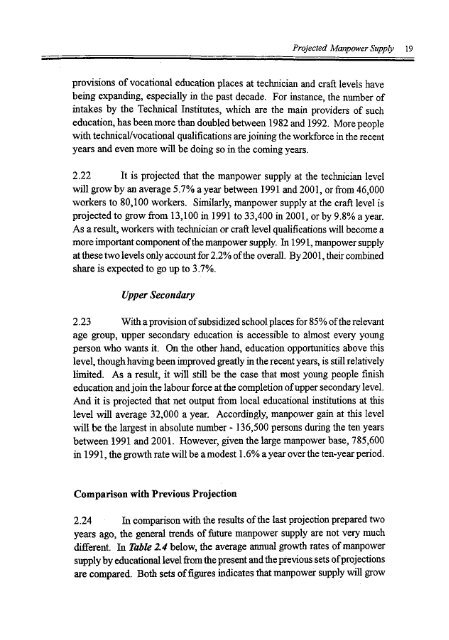Projected Manpower Requirements - HKU Libraries - The University ...
Projected Manpower Requirements - HKU Libraries - The University ...
Projected Manpower Requirements - HKU Libraries - The University ...
Create successful ePaper yourself
Turn your PDF publications into a flip-book with our unique Google optimized e-Paper software.
<strong>Projected</strong> <strong>Manpower</strong> Supply 19<br />
"""•P^^<br />
provisions of vocational education places at technician and craft levels have<br />
being expanding, especially in the past decade. For instance, the number of<br />
intakes by the Technical Institutes, which are the main providers of such<br />
education, has been more than doubled between 1982 and 1992. More people<br />
with technical/vocational qualifications are joining the workforce in the recent<br />
years and even more will be doing so in the coming years.<br />
2.22 It is projected that the manpower supply at the technician level<br />
will grow by an average 5.7% a year between 1991 and 2001, or from 46,000<br />
workers to 80,100 workers. Similarly, manpower supply at the craft level is<br />
projected to grow from 13,100 in 1991 to 33,400 in 2001, or by 9.8% a year.<br />
As a result, workers with technician or craft level qualifications will become a<br />
more important component of the manpower supply. In 1991, manpower supply<br />
at these two levels only account for 2.2% of the overall. By 2001, their combined<br />
share is expected to go up to 3.7%.<br />
Upper Secondary<br />
2.23 With a provision of subsidized school places for 85% of the relevant<br />
age group, upper secondary education is accessible to almost every young<br />
person who wants it. On the other hand, education opportunities above this<br />
level, though having been improved greatly in the recent years, is still relatively<br />
limited. As a result, it will still be the case that most young people finish<br />
education and join the labour force at the completion of upper secondary level.<br />
And it is projected that net output from local educational institutions at this<br />
level will average 32,000 a year. Accordingly, manpower gain at this level<br />
will be the largest in absolute number -136,500 persons during the ten years<br />
between 1991 and 2001. However, given the large manpower base, 785,600<br />
in 1991, the growth rate will be a modest 1.6% a year over the ten-year period.<br />
Comparison with Previous Projection<br />
2.24 In comparison with the results of the last projection prepared two<br />
years ago, the general trends of future manpower supply are not very much<br />
different. In Table 2.4 below, the average annual growth rates of manpower<br />
supply by educational level from the present and the previous sets of projections<br />
are compared. Both sets of figures indicates that manpower supply will grow

















